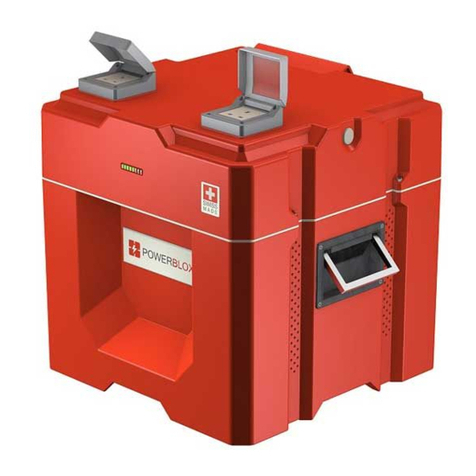Installation and Operating Instructions PBX-200 PB / Li page 2
Table of Contents
1!GENERAL(SAFETY(INSTRUCTIONS(...................................................................................................................(3!
2!SCOPE(OF(DELIVERY(......................................................................................................................................(4!
3!INTENDED(USE(..............................................................................................................................................(5!
4!MARKINGS(....................................................................................................................................................(6!
4.1!SYMBOLS!FOR!WARNINGS!AND!NOTES!...................................................................................................................!6!
4.2!SIGNAL!WORDS!.................................................................................................................................................!6!
5!QUICK(START(GUIDE(......................................................................................................................................(7!
6!OVERVIEW(OF(THE(POWER(BLOX(..................................................................................................................(8!
6.1!LEGEND!OF!COMPONENTS!AND!CONNECTIONS!......................................................................................................!10!
7!INSTALLATION(.............................................................................................................................................(11!
7.1!SAFETY!INSTRUCTIONS!......................................................................................................................................!11!
7.2!CONNECTIONS!AND!MAIN!SWITCH!......................................................................................................................!13!
!"#"$!%&'()*+',-.)/01)""""""""""""""""""""""""""""""""""""""""""""""""""""""""""""""""""""""""""""""""""""""""""""""""""""""""""""""""""""""""""""""""""""""")$0!
!"#"#!2'34-,)-5((4-,'5()6'&)'(,473&,48)*5-94,*)/$1)"""""""""""""""""""""""""""""""""""""""""""""""""""""""""""""""""""""""""""""""""""""""""")$0!
!"#"0!:*4),.4):;<)-5((4-,53*)/=1)/>1)&(8)$#)?)2@)""""""""""""""""""""""""""""""""""""""""""""""""""""""""""""""""""""""""""""""""""""""""""")$=!
!"#"=!@5((4-,'(7),.4)*5A&3)B58CA4),5),.4)*5A&3)*5-94,)/D1)"""""""""""""""""""""""""""""""""""""""""""""""""""""""""""""""""""""""""""""")$=!
!"#">!@5CEA'(7)5F)G5+43H<A5I)""""""""""""""""""""""""""""""""""""""""""""""""""""""""""""""""""""""""""""""""""""""""""""""""""""""""""""""""""""""""""")$>!
!"#"J!%'('BCB)8'*,&(-4*)"""""""""""""""""""""""""""""""""""""""""""""""""""""""""""""""""""""""""""""""""""""""""""""""""""""""""""""""""""""""""""""""")$!!
!"#"!!K(,43-5((4-,'(7)*4643&A),5+43*),5)&)LE5+43)+&AAL)"""""""""""""""""""""""""""""""""""""""""""""""""""""""""""""""""""""""""""""""""")$!!
!"#"D!:*'(7),.4)-5((4-,'5(),43B'(&A*)/$JH$M1)"""""""""""""""""""""""""""""""""""""""""""""""""""""""""""""""""""""""""""""""""""""""""""""""""")$D!
7.3!CONNECTION!TYPES!.........................................................................................................................................!21!
7.4!SINGLE!SOLAR!SYSTEM!......................................................................................................................................!21!
7.5!COMBINATION!OF!SOLAR!AND!PUBLIC!ELECTRICITY!.................................................................................................!21!
7.6!USE!AS!BACKUP!SYSTEM!(UPS)!..........................................................................................................................!22!
7.7!COMBINED!SOLAR!/!MAINS!SYSTEM!WITH!CONNECTION!TO!THE!TERMINAL!BLOCK!.......................................................!22!
7.8!POWER-BLOX!INSTALLATION!.............................................................................................................................!23!
!"D"$!K(*,&AA&,'5()5F)&)*'(7A4)G5+43H<A5I)""""""""""""""""""""""""""""""""""""""""""""""""""""""""""""""""""""""""""""""""""""""""""""""""""""""""")#0!
!"D"#!K(*,&AA&,'5()5F)&88','5(&A)G5+43H<A5I),5)&),5+43)53)&)G5+43HN&AA)/B&I'BCB)M)C(',*1)"""""""""""""""""""""""""")#=!
!"D"0!K(*,&AA&,'5()5F)E5+43)*O*,4B*)734&,43),.&()M)G5+43H<A5I)"""""""""""""""""""""""""""""""""""""""""""""""""""""""""""""""""""""")#=!
8!INITIAL(START-UP(........................................................................................................................................(25!
9!LED(DISPLAY(................................................................................................................................................(26!
9.1!INDICATES!THE!BATTERY!STATUS!.........................................................................................................................!26!
9.2!DISPLAY!ON!SYNCHRONIZATION!..........................................................................................................................!26!
9.3!DISPLAY!OF!ERRORS!.........................................................................................................................................!26!
10!TROUBLESHOOTING
(..................................................................................................................................(27!
11!MAINTENANCE(............................................................................................................................................(28!
12!DISPOSAL(....................................................................................................................................................(29!
13!TECHNICAL(DATA(........................................................................................................................................(30!
14!DISCLAIMER(OF(LIABILITY(............................................................................................................................(32!
15!WARRANTY(AND(GUARANTEE(PROVISIONS(................................................................................................(33!
16!HOW(TO(CONTACT(WITH(.............................................................................................................................(37!
17!NOTES(.........................................................................................................................................................(38!




























